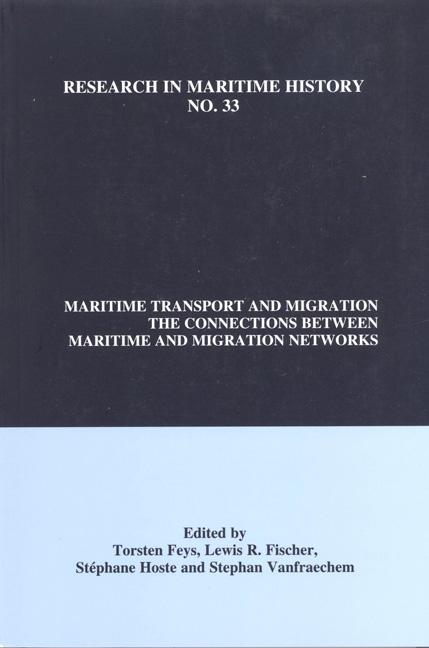Book contents
- Frontmatter
- Contents
- Contributors' Notes
- “Migration and Maritime Networks in the Atlantic Economy: An Introduction”
- “The First Waves of Internationalization: A Comparison of Early Modern North Sea and Nineteenth-Century Transatlantic Labour Migrations”
- “The Battle for the Migrants: The Evolution from Port to Company Competition, 1840-1914”
- “The Role of Foreign-bora Agents in the Development of Mass Migrant Travel through Britain, 1851-1924”
- “Transatlantic Emigration and Maritime Transport from Greece to the US, 1890-1912: A Major Area of European Steamship Company Competition for Migrant Traffic”
- “The ‘Relatives and Friends Effect:’ Migration Networks of Transatlantic Migrants from the Late Habsburg Monarchy”
- “Crossing the Last Frontier: Transatlantic Movements of Asian Maritime Workers, c. 1900-1945”
- “Costs, Risks and Migration Networks between Europe and the United States, 1900-1914”
- “Conclusion”
“Migration and Maritime Networks in the Atlantic Economy: An Introduction”
- Frontmatter
- Contents
- Contributors' Notes
- “Migration and Maritime Networks in the Atlantic Economy: An Introduction”
- “The First Waves of Internationalization: A Comparison of Early Modern North Sea and Nineteenth-Century Transatlantic Labour Migrations”
- “The Battle for the Migrants: The Evolution from Port to Company Competition, 1840-1914”
- “The Role of Foreign-bora Agents in the Development of Mass Migrant Travel through Britain, 1851-1924”
- “Transatlantic Emigration and Maritime Transport from Greece to the US, 1890-1912: A Major Area of European Steamship Company Competition for Migrant Traffic”
- “The ‘Relatives and Friends Effect:’ Migration Networks of Transatlantic Migrants from the Late Habsburg Monarchy”
- “Crossing the Last Frontier: Transatlantic Movements of Asian Maritime Workers, c. 1900-1945”
- “Costs, Risks and Migration Networks between Europe and the United States, 1900-1914”
- “Conclusion”
Summary
European migration rose from an average of just over 110,000 people per year in the period 1821-1850, to 270,000 between 1851 and 1880 and to more than 900,000 in the years 1881-1915. In total, some eleven or twelve million Europeans migrated before the 1880s compared with thirty-two million after that date. The Americas, led by the United States (sixty-two percent), Argentina (nine percent), Canada (eight percent) and Brazil (seven percent), received more than eighty-five percent of recorded immigration. In the heyday of this transatlantic passenger shipping between 1900 and 1914, the four largest US ports alone welcomed eleven million European migrants. Italy, the largest exporter of labour across the Atlantic, accounted for twenty-three percent of total European migration, while Britain and Germany, the two largest transmigration countries, handled about one-fifth of the total flow. Added to the tens of thousands of migrants who departed each year from the ports of Bremen, Hamburg, Liverpool and Southampton were similar numbers who travelled to Antwerp, Genoa, Le Havre, Marseille, Naples, Rotterdam and Trieste to commence the transatlantic crossing.
The acceleration in the migration rate from the 1880s coincided with a remarkable shift in the labour outflow from northern and western Europe to southern and eastern Europe. The incidence of migration was, however, not spread evenly across countries but was higher from some than from others. For this reason, the nation-state may not be the appropriate unit of analysis, although state and nation should not be excluded from any study of the networks that facilitated transatlantic migration. On the other hand, the history of the major European port cities suggests that the Atlantic labour market was segmented. If the development of the Atlantic economy was a significant cause of emigration, we would expect that the earliest migrants came from areas near ports. But emigration rates from the vicinity of port cities were particularly low, although some pioneers, often merchants, emigrated. First and foremost, these cities became important migration ports for people from other countries.
Migration and shipping are both as old as human history, but this has not hindered migration historians from neglecting, to a certain extent, the impact of maritime networks on migration, while it is also true that few maritime historians have considered migration patterns and their networks.
- Type
- Chapter
- Information
- Maritime Transport and MigrationThe Connections Between Maritime and Migration Networks, pp. 1 - 8Publisher: Liverpool University PressPrint publication year: 2007



